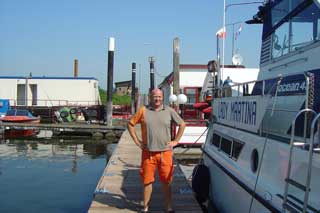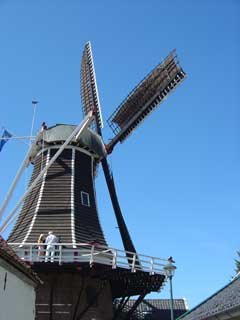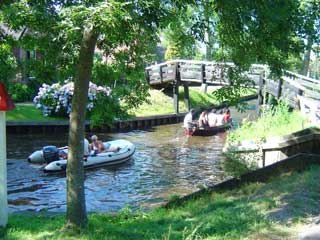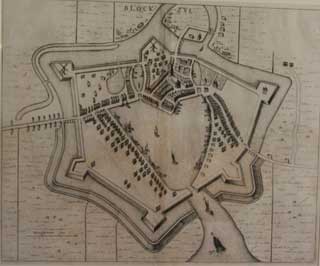Deventer to Urk, via the Kop van Overijssel
Saturday 15th - Thursday 20th July
 One
week and two garage bills later we were ready to leave Deventer, with
our research on the Twentekanalen and the Overijsselse Vecht complete.
We continued north on the IJssel making a short stop at the pretty Hanseatic
town of Hattem, where we visited the old mill where they still grind corn
into flour, and the old bakery museum where they use the flour to give
bread-baking demonstrations. The old centre is very picturesque and the
convenience of the nearby harbour makes this is a must-visit location.
In late afternoon we made our way past Zwolle, turning onto the Zwolle-IJsselkanaal
and then the Zwarte Water to reach the last of the Hanseatic towns of
this region, at Hasselt. Here we made an overnight stop on the "VVV
steiger", a town centre quayside mooring, for which a volunteer harbour
master collects a modest fee.
One
week and two garage bills later we were ready to leave Deventer, with
our research on the Twentekanalen and the Overijsselse Vecht complete.
We continued north on the IJssel making a short stop at the pretty Hanseatic
town of Hattem, where we visited the old mill where they still grind corn
into flour, and the old bakery museum where they use the flour to give
bread-baking demonstrations. The old centre is very picturesque and the
convenience of the nearby harbour makes this is a must-visit location.
In late afternoon we made our way past Zwolle, turning onto the Zwolle-IJsselkanaal
and then the Zwarte Water to reach the last of the Hanseatic towns of
this region, at Hasselt. Here we made an overnight stop on the "VVV
steiger", a town centre quayside mooring, for which a volunteer harbour
master collects a modest fee.
 Although
still blessed with many historic old buildings, Hasselt is much less touristy
than Hattem, which is either good or bad depending on your point of view.
The few restaurants were mainly empty except for the one where the locals
congregate, erupting into community singing by the end of the evening.
The most popular venue was the St Stephanus church which attracted a joyous
congregation on Sunday morning, whilst the rest of the town fell quiet.
Although
still blessed with many historic old buildings, Hasselt is much less touristy
than Hattem, which is either good or bad depending on your point of view.
The few restaurants were mainly empty except for the one where the locals
congregate, erupting into community singing by the end of the evening.
The most popular venue was the St Stephanus church which attracted a joyous
congregation on Sunday morning, whilst the rest of the town fell quiet.
After a visit to the restored lime kilns we continued our voyage north, stopping briefly for a look round the old barge village of Zwartsluis, and then making our way via the Meppelerdiep to the Kanaal Beukers-Steenwijk. This small waterway was dug in the 1920's in connection with the peat extraction that took place in the area, and now these lakes and waterways are a leisure boating mecca.
 The
village of Giethoorn, also called the "Green Venice of the North"
on account of its numerous canals and gondola shaped boats, is the focal
point of the area, and on a sunny Sunday afternoon is teeming with small
boats. The main canal gets very busy, but small boats can venture into
the central canals of the village, where centuries old thatched farmhouses
have been converted for recreational and residential use. By evening the
majority of visitors had departed and we could make a more comfortable
tour of the waterways, stopping at the canalside Italian restaurant, Fratelli,
for a high class repast of pizza and ice-cream.
The
village of Giethoorn, also called the "Green Venice of the North"
on account of its numerous canals and gondola shaped boats, is the focal
point of the area, and on a sunny Sunday afternoon is teeming with small
boats. The main canal gets very busy, but small boats can venture into
the central canals of the village, where centuries old thatched farmhouses
have been converted for recreational and residential use. By evening the
majority of visitors had departed and we could make a more comfortable
tour of the waterways, stopping at the canalside Italian restaurant, Fratelli,
for a high class repast of pizza and ice-cream.
The Kanaal Beukers-Steenwijk links together with a series of small waterways in the region called the Kop van Overijssel, which form a mast-up route between Friesland and the Randmeren, or a circular route from the Ketelmeer. The route passes through a National Park and then takes in the old seaports of Blokzijl and Vollenhove, which lay on the east side of the IJsselmeer until the draining of the Noordoostpolder in 1942. The visitors harbour at Blokzijl is still in the old pool where the cargo ships unloaded their wares in the 17th century.
 From
Vollenhove we locked down several metres into the Noordoostpolder and
followed the canal across the polder to arrive at Urk, by the back door.
Unfortunately, although the lock was due to close at 7pm, our 6.30pm arrival
proved too late as a large houseboat was locking through in front of us
and by the time that had cleared the time was up.
From
Vollenhove we locked down several metres into the Noordoostpolder and
followed the canal across the polder to arrive at Urk, by the back door.
Unfortunately, although the lock was due to close at 7pm, our 6.30pm arrival
proved too late as a large houseboat was locking through in front of us
and by the time that had cleared the time was up.
Cruising Statistics
Distance (inland): 72 nm
Total to date: 772 nm
Avg Speed: 4.6 kn
Duration: 15:30 hrs
Diesel: 83 ltrs
Mooring:
€8 at Hasselt;
€13 at Giethoorn;
Free at Ossenzijl;
€13 at Vollenhove;
Free at Urkersluis waiting pontoon; €15 at Urk harbour
Electricity:
N/A at Hasselt, Ossenzijl & Urk; €1/2kWh at Giethoorn & Vollenhove;
Included at Urk harbour (10A)
Water:
€0,50/100l at Hasselt, Giethoorn & Vollenhove; N/A at Urk
Charts
ANWB Noord-Nederland (electronic folio)
ANWB D Gelderse IJssel
Locks
Spooldersluis
Beukersluis
Blokzijl
Voorstersluis
Marknessersluis
Urkersluis
Bridges
19 opening
13 fixed (min 5.3m)